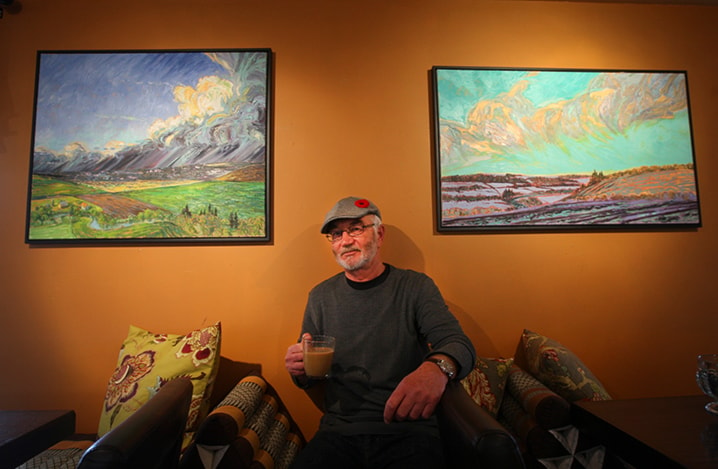Central Alberta artist David More often has his eyes to the skies — and he’s been troubled by changes he’s noticing.
Extreme weather patterns, due to global warming, are causing more turmoil above us, said More, whose latest paintings on this theme are showing in the Vanishing Point exhibit at The Coconut Room, upstairs at Sunworks in Red Deer.
The Benalto resident can trace his interest in unusual weather progressions back to a hot afternoon on July 14, 2000.
More was painting the prairie landscape just north of his community when he noticed the buildup of strange storm clouds, like nothing he had ever seen before.
He was suddenly overcome by an ominous impulse. “Something compelled me to reach down and grab a big swab of red paint and smear it on the canvas and work it into the clouds I was painting,” he recalled.
A few seconds later he was perplexed by what he’d done. The retired Red Deer College art instructor remembers questioning his instinct, since the unsettling red on his canvas didn’t match anything he was actually observing in nature.
“I was fascinated, but it also frightened me.”
More was even more shaken that evening after learning that a tornado killed 12 people in a campground near Pine Lake. The deadly twister was thought to have originated from a storm cell that began building in the exact vicinity where he had been painting at 3 p.m. that day.
“Some instinct that I had scared the hell out of me, because somehow I knew — yet I didn’t want to know ... I didn’t want to be a forecaster of doom,” said the artist.
His prescience weighed on his mind. “For years, I didn’t know how to cope with it,” said More.
Although he set aside his first painting of the red-tinged sky, titled Storm of Sorrows (More refuses to sell it), he ended up with something of a sky obsession. “I thought: how do I deal with this, as an artist?”
He began regularly painting the more turbulent cloud patterns that emerged overhead. “Slowly, as the decade wore on, I came to terms with it,” said the 67-year-old, who has become attuned to climate change.
Most weather experts now agree that global warming is causing more extreme weather patterns, including wind storms, flooding and wildfires, on the Prairies and everywhere else.
The 10 paintings and three pastels drawings in his Vanishing Point exhibit, are divided between East Coast seascapes and Central Alberta landscapes. More said peculiar clouds are regularly hovering over all of us — and he sought to capture some of their strangeness and scale in his artworks.
There’s a reoccurring theme of immense nature dwarfing humans and our man-made world.
In Figure on a Shore, viewers can hardly pinpoint the tiny person walking along the ocean in New Brunswick. A monstrous purple cloud stretches like an arm overhead, contrasting sharply with the orange sunset sky. “It’s almost pretty, but there’s something not quite right about it,” observed More.
In Prairie Flash, three grain bins are made insignificant by an ominously churning sky. Some acid undertones in this landscape painted north of Benalto suggests the unnaturalness of the scene.
The artist admitted there could be Biblical allusions to the painting Fire and Hope, which contains a tiny country church found east of Eckville. Rising plumes of white smoke from a wildfire are being pushed forward by the wind and contrast sharply with looming black clouds overhead.
Morning at Percé was painted on Quebec’s Gaspé peninsula and shows the famous flat-topped rocks that can be seen from shore. Although giant to us, they are small in relation to the unrestful air movements above. More noted the absolute calmness of the water is contrasted with the disturbance. “Something is going to happen. It’s a suspended moment.”
Another striking water scene is Last Sailing at Percé: From a tiny Gaspé village, a miniscule ferry crosses ocean waters that look eerily luminescent, reflecting the yellowish sky. More used a pallet knife to create a windswept atmosphere.
The artist often uses an unexpected salmon hue to suggest unnaturalness in his clouds. The colour is often considered decorative but “put into a different context, it changes quite a bit,’ said More.
He admitted the sky paintings offered a release, since they allowed him to “exorcise” some of his feelings about climate change, the same way as his earlier series of forest paintings with acidic hues allowed him to say something about his acid rain anxieties.
The artist is pleased that many industries have cut emissions to reduce the problem of acid rain over the past couple of decades. But climate change has emerged as even more of a seemingly insurmountable global problem.
“I feel powerless about global warming,” said More, who hopes to stir discussion and awareness of it through his powerful and subtly disturbing paintings.
“I’ve discovered I’m not very good at shouting my message out and I’m not strong enough to beat people over the head because a factory is polluting the air ... so I asked myself, how can I deal with what I’m feeling?”
The artworks in Vanishing Point are More’s answer.
The exhibit continues to Jan. 3.
lmichelin@www.reddeeradvocate.com
